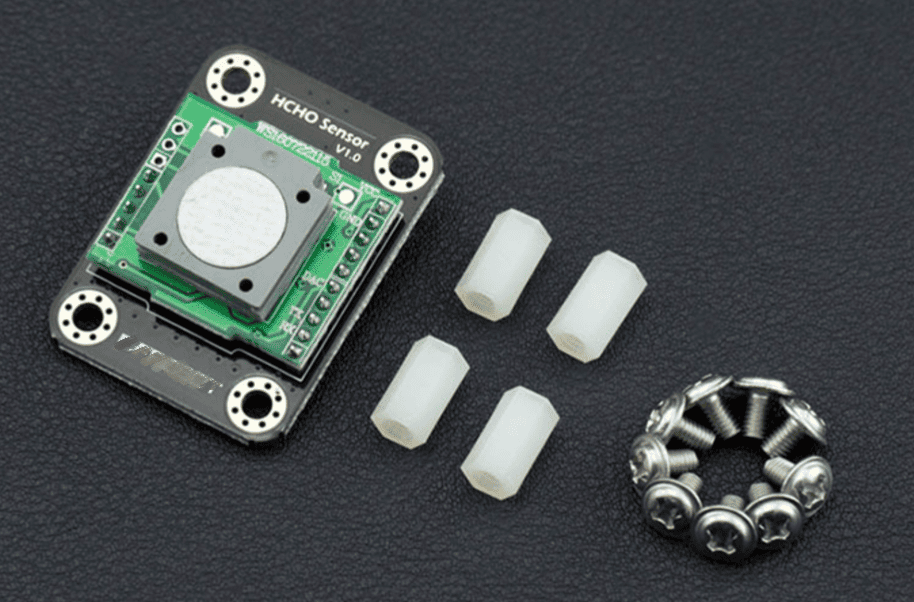Formaldehyde (HCHO) is a colorless, flammable, and strong-smelling chemical widely used in building materials and household products. Its presence in indoor environments is concerning, as it can be released into the air over extended periods ranging from 3 to 15 years. Elevated emissions of formaldehyde are commonly associated with higher temperatures and humidity levels, making it a persistent challenge in maintaining healthy indoor air quality.
Exposure to formaldehyde can lead to various health issues. Short-term exposure may cause symptoms such as nausea, skin irritation, and burning sensations in the eyes, nose, and throat. Prolonged exposure to high levels of formaldehyde is more dangerous and has been linked to cancer in humans, as identified by the International Agency for Research on Cancer (IARC), which classifies formaldehyde as a human carcinogen.
In response to these risks, formaldehyde sensors have become crucial tools for detecting and mitigating the presence of this harmful compound in indoor environments.
Formaldehyde sensors are sophisticated devices designed to monitor and measure the concentration of formaldehyde in the air. These sensors play a vital role in detecting harmful levels of formaldehyde, ensuring that indoor environments remain safe and conducive to health.
Modern formaldehyde sensors are equipped with advanced technology, enabling them to provide accurate, real-time measurements. They are often integrated into air quality monitoring systems to enhance their functionality and effectiveness.

Formaldehyde sensors have a broad range of applications across various industries and settings. Below are some key areas where these sensors are utilized:
Formaldehyde sensors are integrated into devices like air monitors, air purifiers, and fresh air systems. Together with other sensors, such as PM2.5 sensors, temperature sensors, and humidity sensors, they work to create a comprehensive air quality management system. These integrated solutions promote healthier living environments by effectively detecting and mitigating pollutants.
Modern homes are increasingly equipped with smart appliances. Formaldehyde sensors are being incorporated into smart air conditioners and ventilation systems to enhance their air quality control features. This integration ensures that households are protected from the dangers of formaldehyde exposure.
Portable air quality detectors equipped with formaldehyde sensors are ideal for on-the-go monitoring. These devices provide real-time data on air quality, making them valuable for personal use and professional applications.
In industrial and public spaces, IoT-enabled air quality monitoring stations often incorporate formaldehyde sensors to provide comprehensive environmental data. This integration ensures that air quality standards are maintained and potential hazards are identified promptly.
For enthusiasts and educational purposes, formaldehyde sensors can be paired with microcontrollers like Arduino and Raspberry Pi. This flexibility allows hobbyists and students to develop custom air quality monitoring solutions.
Formaldehyde sensors are designed with various features to ensure reliability and accuracy in detecting formaldehyde levels:
These sensors are capable of detecting formaldehyde concentrations as low as 0.01 ppm, with a wide detection range of 0-5 ppm.
They support diverse output methods, including UART and analog voltage output, allowing seamless integration into different systems.
Formaldehyde sensors are built for durability, offering stable performance and excellent resistance to interference over time.
Advanced temperature compensation technology ensures accurate readings even in fluctuating environmental conditions.
Designed for energy efficiency, these sensors have a prolonged lifespan of up to five years, making them cost-effective solutions for air quality monitoring.
The adoption of formaldehyde sensors provides numerous benefits:
By accurately detecting formaldehyde levels, these sensors help mitigate health risks associated with exposure to this hazardous chemical.
When combined with other air quality sensors, formaldehyde sensors contribute to a holistic understanding of indoor environmental conditions.
With low power consumption, these sensors are ideal for continuous monitoring without significantly increasing energy costs.
The availability of multiple output methods and compatibility with various platforms makes these sensors highly adaptable for diverse applications.
Portable detectors equipped with formaldehyde sensors empower individuals to monitor their surroundings, fostering greater awareness of air quality.
In today’s smart world, where IoT devices and smart home technologies are increasingly prevalent, formaldehyde sensors have become integral components. They not only enhance air quality management but also contribute to sustainable living by enabling energy-efficient systems.
From personal health protection to large-scale environmental monitoring, formaldehyde sensors are at the forefront of efforts to create healthier and safer indoor environments.
As the importance of indoor air quality continues to gain recognition, formaldehyde sensors stand out as essential tools in the fight against air pollution. Their versatility, accuracy, and integration capabilities make them indispensable for both personal and professional applications.
Whether in a smart home setup, industrial monitoring station, or portable detector, formaldehyde sensors play a critical role in safeguarding health and promoting well-being. With advancements in sensor technology, the future of air quality monitoring looks promising, paving the way for healthier indoor environments and improved quality of life.
Previous: Differences Between Laser and Infrared Principles in PM2.5 Sensors
Next: CO2 Monitors for Schools: Ensuring Healthy Indoor Air Quality




